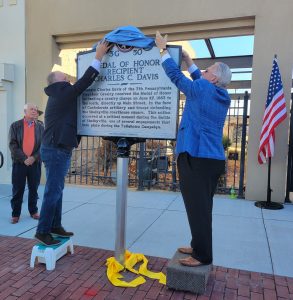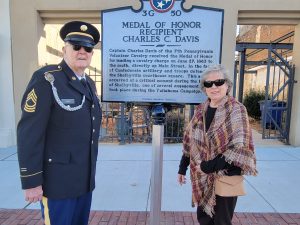The Shelbyville Historic Square has a new marker for local history lovers.
By ZOË WATKINS
zwatkins@bedfordcountypost.com

Mayors Graham and Carroll helped unveil the marker.
The new marker, which was unveiled on Veteran’s Day in front of Pope’s Café, honors American Civil War veteran Capt. Charles C. Davis of the 7th Pennsylvania Volunteer Cavalry.
Davis received the Medal of Honor for leading a cavalry charge on June 27, 1863, directly up Main Street, “in the face of Confederate artillery and troops defending the Shelbyville Courthouse square,” the plaque reads.
This action of Capt. Davis occurred at a “critical moment” during the Battle of Shelbyville which was one of the engagements that took place during the Tullahoma Campaign in the summer of 1863.
Blair Ross, the plaque’s project officer from the VFW, explained the skirmish further.
Following the Battle of Stones River in January 1863 — which saw a total of 23,000 soldiers killed, wounded, or missing — Union General William Rosecrans, commanding the Army of the Cumberland, rested and rebuilt his forces, according to Ross.
“Though victorious, they had been badly battered in that encounter by Confederate General Braxton Bragg’s Army of Tennessee,” said Ross.
After Stones River, Bragg had withdrawn his forces toward the Highland Rim in order to defend the approaches to Chattanooga, a major Confederate depot and transportation hub.
His defenses were generally to the north of the Duck River as well as Hoover’s Gap, Liberty Gap, Bell Buckle, and near Shelbyville, according to Ross.
Bragg initially deployed General Leonidas Polk’s corps. to defend Shelbyville and its surrounding areas. To do so, they built extensive entrenchments around the town.
“Some of these were uncovered during the construction of the Highway 437 Bypass,” said Ross. “Traces of these works remain on many properties in Bedford County.”
But by June of 1863, Gen. Rosecrans had rebuilt his army enough to resume the offenses.
“He [Rosecrans] was being pressured by both military and political authorities in Washington to continue his attacks down here into Middle Tennessee,” he said.
One June 24, Rosecrans’s Army finally began to advance from positions around Murfreesboro to threaten Chattanooga, initiating the Tullahoma Campaign.
“By the end of the day June 26, two days later, it was clear to Bragg that the main attack was coming on his right flank towards Manchester. The maneuvers and early successes of the Union Army around Wartrace and Hoover’s Gap compelled Bragg to order withdrawal and concentrate around Tullahoma,” said Ross.
He order Gen Polk to withdraw his corps. from around Shelbyville before engagement and cross over the Duck River to protect Tullahoma. To delay Union advance and protect them during the river crossing, Polk ordered Gen. Joe Wheeler’s cavalry corps to guard the rear, north of Deason and in Shelbyville.
But the Union Army came marching down what is now U.S. 231 North by June 27, impressing on Wheeler’s rear guard.
The Union cavalry brigade pressed forward through Shelbyville and over the Duck River.
“Elements of Wheeler’s Cavalry Corps. resisted this attack, attempting to protect the Skull Camp Bridge crossing,” said Ross. “It’s very close to where the Highway 130 Bridge is now. If you look into the woods as you cross over the bridge, downstream, you can still see the pillars of where this bridge stood.”
The Confederates fell back toward Shelbyville where they hastily established a sizeable detachment to defend the Courthouse Square. The defense was centered very close to where the marker is now, facing up Main Street.
This is where Capt. Davis, in command of four mounted companies of the 7th Pennsylvania Volunteer Cavalry, was ordered to break through these defenses and attempt to secure the bridge and block any further retreat.
“He formed his troops, 150 to 200 riders, in the general vicinity of where the Post Office now stands. He then led the companies in a desperate charge in the face of Confederate artillery and rifle fire directly up [Main Street, U.S. 231 North] and into the public square,” said Ross.
They broke through the Confederate position after a furious engagement and ultimately captured the bridge.
Davis was subsequently awarded the Medal of Honor.

Watching the unveiling were Jim and Rita Short. Jim Short served in the U.S. Army from March 1975 to 1995.
But even studious learners of the American Civil War may not entirely be familiar with Davis and the Tullahoma Campaign.
“This campaign, though quite significant in terms of importance to the war’s outcome, is not very widely known among the American public. The primary reason for that is that it took place at the same time as the momentous battles of Gettysburg and Vicksburg, which then as now, have drawn most of the public attention,” said Ross.
Even so, Capt. Davis and his contribution will forever be remembered by anyone passing through Shelbyville’s Square which once saw the turmoil of brother turned against brother.
“Understanding the Tullahoma Campaign and the actions in Bedford County should nevertheless be very interesting to the members of our community through whose streets, yards, and fields these armies marches, camped, and fought,” said Ross.
“We dedicate this marker to commemorate Capt. Davis’ valor. We hope that it will well represent the spark of courage that burns in the breast of every veteran,” said Ross.



![For-Tips-and-Ideas-Phone-300x250-Bedford-County-Post[1]](https://www.bedfordcountypost.com/wp-content/uploads/2023/09/For-Tips-and-Ideas-Phone-300x250-Bedford-County-Post1-300x250.jpg)
![Subscribe-Now-300x250-Bedford-County-Post[1]](https://www.bedfordcountypost.com/wp-content/uploads/2023/09/Subscribe-Now-300x250-Bedford-County-Post1-300x250.jpg)

